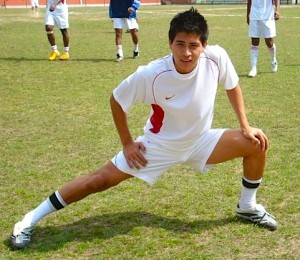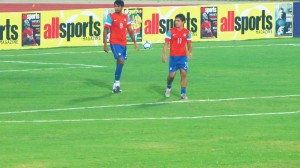After a gap of 27 years, India finally qualified for Asian Cup again. Being grouped with three of the strongest teams in Asia didn’t do the team any favours. As expected, India slumped to heavy losses in each of the three matches. However, the results do not mean that India is not taking anything positive away from Asian Cup 2011. There were plenty of positives and encouraging signs from India’s campaign.
Defence
Perhaps the biggest let down for Indian fans in Asian Cup was the backline. Weakness in flanks hurt the team in each of the matches. Against Australia, India started solidly but was undone by a faulty offside trap. Two of Bahrain’s five goals were because of faults in the offside trap. In that match, the fleet-footed Jaycee John caused a lot of problems to Indian backline and caught it flat-footed on too many occasions. The lack of co-ordination between defenders was ridiculous at times despite spending a long time together in National Camps.
Subrata Pal
Unarguably India’s best performer in Asian Cup. In last 3 years, Subrata has performed consistently and is one of the few Indian players who are capable of playing against the best in Asia. He made acrobatic saves in every single game and was solely responsible for India conceding lesser goals. Against Korea he made an incredible 22 saves and denied several golden opportunities. This tournament highlighted Subrata’s biggest strength – his sharp reflexes. However, it also highlighted his obvious weaknesses. Subrata is prone to occasional lapses in concentration and makes errors often. Australia’s 3rd goal, Bahrain’s 2nd goal and Korea’s 1st goal were all due to mistakes by him. Right now he is good enough to play in Indonesian or Malaysian leagues; if he wants to make a transition to J-League or European clubs he needs to improve his overall game. His ability to organize defence has to improve along with his often dodgy handling of crosses. Subrata is one player who needs to ply his trade outside India. He has the ability to do so and it will be better for Indian football if he does go abroad.
Rating 8.5/10
One man army !
Gourmangi Singh
The Best Indian player of last season had a nightmarish start to the campaign. In first match he looked awed by the enormity of the occasion. He was extremely shaky in defence and completely failed to mark Tim Cahill. Gourmangi was back in his usual elements against Bahrain. Although the backline often failed due to lack of co-ordination, Gourmangi’s individual performance was good. He allowed very little space to Al-Dakeel and tried to move up as a sweeper – often being the starting the point of India’s attacks. He did score India’s first Asian Cup goal in 47 years – with a slightly awkward jab against Bahrain. He had a poor match against Korea but made two goal-line saves.
Rating – 6.5/10
Anwar Ali
Anwar was possibly the most consistent defender for India in Asian Cup. He made numerous timely interceptions to cover up for struggling Gourmangi against Australia. His good match reading enabled him to go for several clean but solid tackles. Anwar’s main weakness is his lack of strength. At times, he looked very light weight and frail against the physically strong opponent strikers and was easily wrestled off the ball.
Rating – 6.5/10
Surkumar Singh
Surkumar’s defensive abilities were under doubt even before Asian Cup started. His performances did precious little to dispel those doubts. He was out of position on many occasions and failed to mark opponent left wingers. The likes of Salman Isa and Harry Kewell enjoyed a lot of space on Surkumar’s flanks because of his lax marking. He did make decent forays into opponent defence occasionally but his final ball always turned out to be pretty poor. It’s about time Indian football finds a new right-back.
Rating – 4/10
Dipak Mandal
The most disappointing performer among Indian defenders. Dipak, at this age, was never suited to play as a left back against the likes of Luke Wilkshire. It was Dipak who played Brett Emerton onside for Australia’s first goal. Rest of the defenders held the offside trap perfectly but Dipak’s positioning was wrong. He huffed and puffed for rest of the match and was woefully off the pace against the Aussie wingmen. He was rightly benched against Bahrain, but came on a second half substitute.
Rating – 3.5/10
Syed Rahim Nabi
Nabi cannot be classified as a pure defender – he played as a left winger against Australia but dropped down to play as a left-back against Bahrain. He had started his career as a striker but over the years has turned into an excellent all-rounder. Sadly, defensive duties are not his strong point and he looked out of sorts defensively in the first two matches. He looked much more comfortable when going on overlaps. In all three matches he effortlessly cut back from the flanks and showed some neat technical skills to beat opponent defenders. It will better for Indian football if Nabi’s offensive skills are utilized in a better way.
Rating – 6/10
Midfield
Indian midfield was good in patches but inconsistent. Against Bahrain, India dominated possession for a long period of time in 2nd half. This was solely due to some intricate pattern play in centre of the park. Wing movement was fluid in all three matches. The Achilles’ heel was lack of a proper destroyer in central midfield. The amount of time the opposition had on the ball was not suited for International football. There was no one to act as a defensive screen to shield an often vulnerable central defence. Someone like Mehtab Hussain would have made a world of difference.
N. Pradeep
Where is the Pradeep of 3 seasons back ? Where is the lanky midfield orchestrator who scored the winner in Nehru Cup final? Instead of that player we now have an unfit and overweight midfielder. Pradeep’s long injury layoff before the Asian Cup drained away his fitness. He was out of shape and out of breath against the physicality of India’s opponents. He was the only Indian player who was substituted in every single match. His ball delivery was poor and the long rangers for which he became famous were non-existent. He was ball watching when Korea scored its opening goal and made no attempt to block the shot.
Rating – 4/10
Climax Lawrence
In absence of Baichung Bhutia, Climax was donned skipper’s armband. Sadly, he didn’t do justice to that band for most of the tournament. A young Climax was a beast of a player – his work-rate and terrier like motivation made him one of the best players in Indian football. Climax is no longer in his physical prime and his overall game has deteriorated considerably. He was guilty of several clumsy tackles in all three matches – one of the tackles resulting in a penalty against Bahrain. His delivery to the strikers was also pretty poor, except the lone long ball from which Chhetri almost scored against the Aussies.
Rating – 5/10
Best Indian midfielder in Asian Cup
Rennedy Singh
Rennedy, despite his age was the pick of Indian midfielders. He came on as a substitute in first match and made an immediate impact by providing a juicy cross to Chhetri. If Sunil had timed his jump to perfection India could have scored a goal in that match. He was rightly given a place in first XI against Bahrain and was one of liveliest players on the pitch. His link-up play with the strikers was excellent and he was one of the few Indians who looked comfortable in possession. It was unfortunate that his thunderbolt against Bahrain was not credited to him. His injury and substitution against Korea weakened India considerably.
Rating – 6.5/10
Steven Dias
Like Climax, Dias is another player who is well past his prime. His main strengths used to be his crosses and set-piece delivery. Any observer watching him for the first time in Asian Cup would be hard pressed to believe this fact. He didn’t deliver a single well placed cross or good free kick. Each of the free kicks that he took was aimed directly at the keeper – as were most of his crosses. The only saving grace for Dias was his workrate. He was one of the few Indian players who kept running from start to finish.
Rating – 5.5/10
Mehrajuddin Wadoo
Mehraj could have made a difference when India struggled without a destroyer in midfield. Being physically strong it was less likely that he would have been outmuscled like Pradeep. But he got precious little match time to judge his abilities.
Rating – N/A
Attack
The last time India played in Asian Cup they made an exit without scoring a single goal. This time three goals were scored against touch opponents. The strikers did better than expected – they got very little service but even then managed to maximize it.
Sunil Chhetri
He was unarguably India’s best outfield player. Chhetri’s performance can be compared to Gyan Asamoah’s performance in world cup. Gyan played as a lone striker and worked extremely hard to retrieve possession from midfield. Sunil technically played as a lone striker as his partners were pretty poor. He often found himself isolated up-top against 2-3 defenders. Yet he managed to curve out chances for himself. He scampered past a sluggish Aussie backline, when he got the first (and only) quality pass against the Aussies. He was an ever present danger against Bahrain, and scored a goal. He was involved in most buildups and showed some cheeky skills. In the last match against Korea, he earned the penalty kick and also converting it calmly. He showed his poacher instincts with a well taken header, deep into injury time against Korea. He timed his run to perfection to beat taller Korean centre-backs and unleashed a powerful header. It was unfortunate that Chhetri didn’t get good service, otherwise he could have scored more goals.
Rating – 8/10
Yadav and Chhetri’s performances were sharply contrasting
Abhishek Yadav
Yadav was an absolute beast in the air and won every header he was supposed to win. Came on as a sub against Australia and nullified Cahill’s aerial threat when he dropped into defence. He did the same thing in the other two matches. India’s aerial weakness was considerably addressed by Yadav. This would have been a good performance if he was a centre-back, which he isn’t. Despite all his aerial dominance he failed to capitalize on a free header against Bahrain. His lack of movement and inability to combine with Chhetri was frustrating at times. Yadav was completely invisible against Korea.
Rating – 4.5/10
Mohammad Rafi
Rafi has often been criticized for not bringing his club form for National team. His performance against Australia in first half won’t make that allegation go away anytime soon. He dropped down deep into midfield but couldn’t do anything meaningful and was correctly substituted after half time.
Rating – N/A
Baichung Bhutia
After serving India for so long, Bhutia deserved some play-time in Asian Cup. He did get some 15 minutes in India’s last match when he came on amidst deafening cheers. India looked energized by his inclusion, and it makes one think what would happen if he had played in all three matches.
Rating – N/A
Coach
Bob Houghton
It is said that a football coach earns his bread during half-time. Houghton certainly did his job well in that respect in first two matches. India came in energized and motivated after the lemon break and performed well. Houghton’s decision to bring on Yadav against Aussies was spot on – it negated Aussies’ aerial threat. He chose correctly to field Rennedy against Bahrain – his crosses and set-piece delivery troubled their weak central defence. Houghton seemed to have injected confidence in his players in the second match at half time. Rarely do we see India going all out to attack a stronger opponent. Against the 5th best team in Asia (one that almost qualified for last 2 World Cups) India dominated possession for a considerable period in the 2nd half. For once Indian players looked like they believed in themselves.
Houghton could have selected a better team
On the other hand, Houghton did make lot of mistakes. Samir Naik and Manju have been suffering from poor fitness over last 2 seasons, yet Houghton didn’t choose to include a fitter left back. India was left with two makeshift LBs – Nabi and Dipak. Neither player was comfortable in defensive duties, which resulted in an incredibly weak left flank. His insistence to play the 4-4-2 irrespective of conditions made India predictable. India’s defensive tactics were questionable as players often didn’t know which man they had to mark – something you would expect the coach to fix. As we already talked about, Houghton’s selections were faulty and had weakened the team even before the tournament started. He made a mistake by not bringing on Baichung Bhutia when India was dominating 10-men Bahrain in the 2nd half. It is debatable how much Baichung would have contributed on the field but his presence itself would have spurred his team-mates on. Houghton’s insistence to start with Climax and Pradeep in every match was baffling. Both players were unfit and struggled to cope with opponent CMs – someone like Mehraj would have added more steel to Indian midfield.
Rating 5/10
Final Conclusion
It will be fair to say India did better than expected. The three goals that the team scored and an excellent 2nd half against Bahrain were certainly the high points. Asian Cup showed where India is lagging behind – fitness and stamina. In terms of skill, Indian players are not far off but defensive co-ordination needs to needs to improve. The Asian Cup should act as a stepping stone for future improvements in the game – India has shown that it has huge potential, but that potential needs to be tapped properly.
Asian football is getting very, very competitive. Teams like Uzbekistan, Jordan and Syria have made improvement by leaps and bounds. Teams like Indonesia, Thailand or Malaysia which didn’t qualify for Asian Cup are also stronger than India. It is high time Indian football authorities get their acts together. Unless Indians adopt a more professional approach, Indian football will keep sliding downwards at the Asian level.








